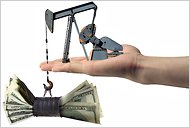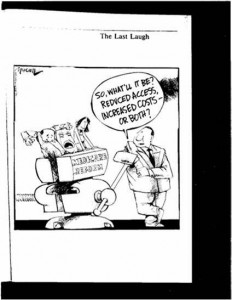
Speaking of property rights, what do “shovel-earned parking dibs and intellectual property law” have in common? One answer is that in each case the producer may not be able to capture the full value of its efforts. Without some sort of protection (a chair, a patent) someone else can come along and “appropriate” the value of your efforts. As Professor Coase would say, the “externality” comes from the high transaction costs of enforcing property rights.
The Cheap Talk blog contemplates this issue and even poses this puzzler:
I wonder how many people who save parking spaces with chairs are also software/music pirates?
See also our post on Pittsburgh last year, where failure to observe the law of the chair met with met with swift justice. Indeed, back in Pittsburgh, people tend to respect the chair whether one shoveled or just woke up early.







 The fashion industry, a $200 billion industry in the United States alone, is comprised of nearly 150,000 establishments, ranging in size from large fashion houses to smaller start-ups. Although there are a large number of firms competing in the industry, according to the 2002 Census, five percent of firms in the clothing industry accounted for twenty percent of total revenue and sales. These large firms, , also play an important role in the diffusion of new design trends and the continuation of induced obsolescence, the dynamic force driving the fashion cycle forward; the influence of large firms contributes to the top-down structure of the industry.
The fashion industry, a $200 billion industry in the United States alone, is comprised of nearly 150,000 establishments, ranging in size from large fashion houses to smaller start-ups. Although there are a large number of firms competing in the industry, according to the 2002 Census, five percent of firms in the clothing industry accounted for twenty percent of total revenue and sales. These large firms, , also play an important role in the diffusion of new design trends and the continuation of induced obsolescence, the dynamic force driving the fashion cycle forward; the influence of large firms contributes to the top-down structure of the industry. As I prepare to pick up Steven Johnson’s
As I prepare to pick up Steven Johnson’s  Cracker and Camper Van Beethoven have a festival, The Campout. It’s rather remote and since we produce the small festival ourselves we take considerable financial risk. While the previous years had been marginally successful we were worried about the rapidly deteriorating economy (I believe Bear Stearns had just gone bankrupt). So I started a campaign to get a “break even” amount of CVB and Cracker fans to commit to attend the festival. In this way our fan’s promises to attend would become a sort of promissory note. no pun intended. While you couldn’t exactly peg it’s value, these collective promises to attend at some point seemed to be worth enough to go ahead and book the flights, PA, lights, and port-o-potties.
Cracker and Camper Van Beethoven have a festival, The Campout. It’s rather remote and since we produce the small festival ourselves we take considerable financial risk. While the previous years had been marginally successful we were worried about the rapidly deteriorating economy (I believe Bear Stearns had just gone bankrupt). So I started a campaign to get a “break even” amount of CVB and Cracker fans to commit to attend the festival. In this way our fan’s promises to attend would become a sort of promissory note. no pun intended. While you couldn’t exactly peg it’s value, these collective promises to attend at some point seemed to be worth enough to go ahead and book the flights, PA, lights, and port-o-potties.